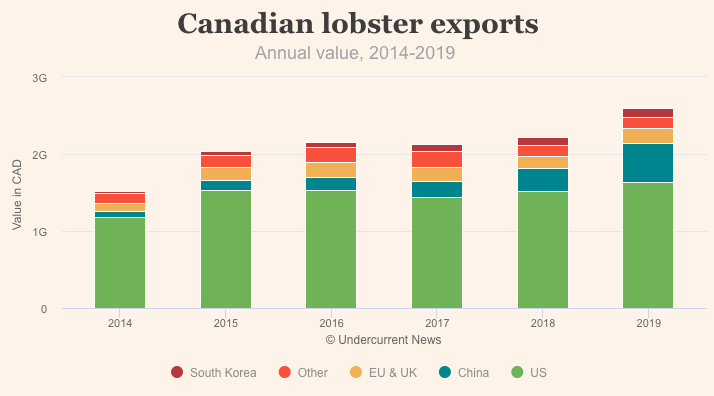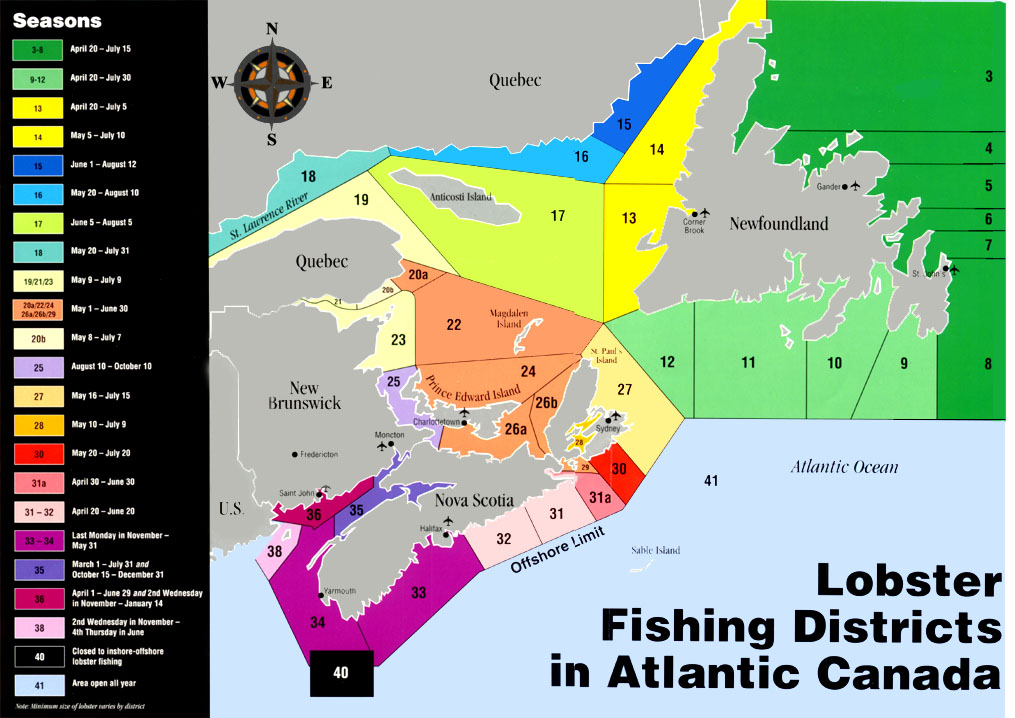Canadian Lobster Fishermen Troubled by Low Prices, Whale Detection, and COVID-19
Over 30% price drop of Canadian lobsters in November
The prices of Canadian lobsters (Homarus americanus) have been unstable since the beginning of the year caused by the oversupply, as a result of the restaurants being closed by COVID-19, and also with the drop in imports of live lobster from the US, China, and Europe. The first 3 weeks of November showed a drop in live hardshell lobster prices from CAD 11.00 per pound to CAD 7~7.50 per pound. The drop in exports to China (the second biggest importer of Canadian lobster, only behind the US) had two main reasons: 1) the drop in demand and 2) the Chinese buying lobster from the US, which, although it is subject to higher taxes, is cheaper than the Canadian product and available throughout the year.
In 2019, the US and China have imported respectively USD 1.2 billion and USD 387 million worth of lobster from Canada, showing the importance of these markets for the lobster industry. By August this year, the total amount exported to China was USD 287 million and seems like it will not show the crescent rate shown in previous years. This year Canada has exported in total USD 1 billion up to August, which is half of the revenues from 2019 which achieved USD 2 billion worth of lobsters.
Despite the decrease in exports, the industry hopes for a good demand for the end of the year celebrations, and aims to target the retailers rather than food services, as the expectation is that more people will celebrate at their homes this year versus going out to a restaurant or a hotel. And also a good demand to supply the Chinese New-Year next February.

Source: Undercurrent News
Fisherman’s concerns
The low pricing concerns the lobster fisherman from Southern Nova Scotia, which their “Dumping day” is close by. Southern Nova Scotia is the most prominent lobster fishing grounds in Canada, they are covered by the Lobster Fishing Areas (LFA) 33 and 34, which are responsible for 30% of the country’s total production. The LFAs are managed by the Department of Fisheries and Oceans Canada who closely monitor the lobster stocks of the area and advise on the need for closures and measures to keep sustainable levels.
The LFA 33 and 34 fishing season is set to start on the last Monday of November of each year to March 31st, where a massive amount of traps are dropped into the zone altogether. This period is set with the purpose of avoiding the capture during the molting and matting period of lobsters for the sustainability of this stock where the commercialization of lobster is prohibited.
The opening of the season is often delayed due to unfavorable weather conditions such as winds above 25 knots which are unsafe for the fleet and fishermen’s work. This year the opening might be delayed by the late detection of the endangered North Atlantic right whales in the region. Since November 9th, several acoustic detections have been reported. The right whales usually have already left the region by now, their detections this late in November are rare. To protect this endangered species from entanglements, the fishing cannot start before they leave. Acoustic gliders and Aerial surveys are being used to check when the fishing can start.

Source: Cape Breton Fish
Another concern is that in June, there was a requirement from the Chinese importers that requested the lobster exporters, to sign a liability declaration saying their lobster is free from COVID-19, and that they will assume liability if any was found to be positive. The measure was taken after the virus was found in imported salmon in the market of Beijing, a place some accuse as being responsible for the outbreak in Summer. The measure has shaken the export community, as live lobster could not wait 36 hours for the test results to be done and it made several exports to be canceled. Many exporters were not willing to sign the liability declaration but were willing to make documents asserting the safety of its products without assuming liabilities.
Source:
Atlantic Fisherman. "LFA 33-34 lobster fishery set to open Nov. 30".
Cape Breton Fish. “Conservation”
CBC Ca. “Impediment blocks lobster shipments”
CBC Ca. “Late year endangered right whale detections close fishery”
Nova Scotia. Industry Overview.
RCI Net. “Lobster dispute between indigenous and commercial fishery boils over again”
Undercurrent News. “COVID-19 recap, Nov.23: Canada lobster prices plummet; IceMar’s US plans; BioMar’s Ecuador project”
Undercurrent News. “Canadian lobster dock prices plummeted weeks before “Dumping Day”
Undercurrent News. “Chinese supports theory imported salmon caused Beijing’s June COVID outbreak”


